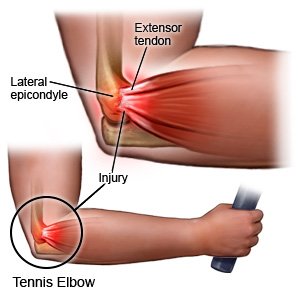Tennis Elbow
Medically reviewed by Drugs.com. Last updated on Aug 4, 2025.
What is tennis elbow?
Tennis elbow is an injury of the tendons in your elbow. Tendons are strong tissues that connect muscle to bone.
 |
What causes tennis elbow?
Tennis elbow is caused by overuse of the muscles in your forearm. These muscles are used to straighten your arm or lift your hand and wrist. Fast, repeated arm movements can lead to inflammation and small tears in your tendon. Tennis, painting, and manual labor are common activities that can cause tennis elbow.
What are the signs and symptoms of tennis elbow?
- Pain in your elbow that travels to your shoulder, forearm, or fingers
- Weakness in your wrist or hand
- Trouble holding, lifting, or grabbing an object, such as a coffee cup
- Red, swollen, or warm skin on the outside of your elbow
How is tennis elbow diagnosed?
Your healthcare provider will feel around your elbow to check for painful areas. The provider will check the movement of your elbow, wrist, and fingers. An x-ray, ultrasound, or MRI may show tendon damage. You may be given contrast liquid to help the tendons show up better in the pictures. Tell the provider if you have ever had an allergic reaction to contrast liquid. Do not enter the MRI room with anything metal. Metal can cause serious injury. Tell the provider if you have any metal in or on your body.
How is tennis elbow treated?
- Acetaminophen decreases pain and fever. It is available without a doctor's order. Ask how much to take and how often to take it. Follow directions. Read the labels of all other medicines you are using to see if they also contain acetaminophen, or ask your doctor or pharmacist. Acetaminophen can cause liver damage if not taken correctly.
- NSAIDs , such as ibuprofen, help decrease swelling, pain, and fever. This medicine is available with or without a doctor's order. NSAIDs can cause stomach bleeding or kidney problems in certain people. If you take blood thinner medicine, always ask your healthcare provider if NSAIDs are safe for you. Always read the medicine label and follow directions.
- A steroid injection will help decrease pain and swelling.
- Physical therapy may be recommended. A physical therapist teaches you exercises to help improve movement and strength, and to decrease pain.
- Surgery may be needed if your symptoms do not improve with other treatments.
Treatment options
The following list of medications are related to or used in the treatment of this condition.
How can I manage my symptoms?
- Wear your support device as directed. Devices, such as an arm strap, brace, or splint, help limit your arm movement. They also decrease pain and help prevent more damage to your tendon. Ask your provider how to care for your arm while you wear a brace or splint.
- Rest your injured arm and avoid activities that cause pain. This will help your tendons heal.
- Apply ice on your elbow for 15 to 20 minutes every hour or as directed. Use an ice pack, or put crushed ice in a plastic bag. Cover the bag with a towel before you apply it to your skin. Ice helps prevent tissue damage and decreases swelling and pain.
- Elevate your elbow above the level of your heart as often as you can. This will help decrease swelling and pain. Prop your elbow on pillows or blankets to keep it elevated comfortably.

When should I seek immediate care?
- You suddenly have no feeling in your arm, hand, or fingers.
- You suddenly cannot move your arm, wrist, hand, or fingers.
When should I call my doctor?
- Your symptoms do not get better within 2 weeks, even with treatment.
- You have more pain or weakness in your arm, wrist, hand, or fingers.
- You have new numbness or tingling in your arm, hand, or fingers.
- You have questions or concerns about your condition or care.
Care Agreement
You have the right to help plan your care. Learn about your health condition and how it may be treated. Discuss treatment options with your healthcare providers to decide what care you want to receive. You always have the right to refuse treatment. The above information is an educational aid only. It is not intended as medical advice for individual conditions or treatments. Talk to your doctor, nurse or pharmacist before following any medical regimen to see if it is safe and effective for you.© Copyright Merative 2025 Information is for End User's use only and may not be sold, redistributed or otherwise used for commercial purposes.
Learn more about Tennis Elbow
Treatment options
Symptoms and treatments
Further information
Always consult your healthcare provider to ensure the information displayed on this page applies to your personal circumstances.
